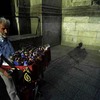Plans Unveiled For Iron Curtain Bike Trail
Plans for a 6,800 km cycle path along the former Iron Curtain ? the line which divided Europe into East and West for almost half a century - were presented at the House of the European Union in Vienna on Monday.
"The big problem in Europe is that we know too little about each other, which leads to resentment," said EU Commissioner Johannes Hahn (?VP).
The track route - to be called the Iron Curtain Trail - will extend from the north of Norway to the Black Sea. It aims to combine European culture, history and sustainable tourism.
Michael Cramer, Chairman of the European Parliament Transport Committee, first came up with the initiative in 2005: ?The bike is fast enough that you can see a lot, and slow enough to actually look at what you're passing," said Cramer. In describing the selection criteria for the trail, Cramer explained that the route was chosen taking into account the proximity to the former border between East and West. The track will also be comfortable to ride, well developed, relatively undisturbed by cars and pass as many memorial sites and places of significance as possible.
Based on the idea of the cycle track which follows the former location of the Berlin Wall, the Iron Curtain Trail will begin at the Russian-Norwegian border at the Barents Sea, follow the Russian-Finnish border, the coastline of the Baltic States and Poland and pass along the former border between East and West Germany. It will then follow the Czech, Austrian, Slovenian, Hungarian, Serbian, Romanian and Bulgarian borders before reaching the Black Sea. The route includes former border crossings, monuments - including the Solidarnosc (Solidarity) memorial in Gdansk and parts of the wall still standing in M?dlareuth, Germany.
Cramer explained that the cost of the bike path will be minimal, as the route includes many already existing and well-marked bike paths, it will only need markers indicating the Iron Curtain Trail to be attached. Brochures about the project are available both on the Internet and in printed form.
In Hahn?s hopes this project would help people to overcome their mental barriers, which always takes longer than tearing down a real Iron Curtain. "According to biologists who have studied the behaviour of deer along the former Iron Curtain, these barriers are also still found in wild animals," says Cramer. "Even third generation animals will turn around at the respective border in Bavaria and Bohemia and do not violate the imaginary curtain.?





